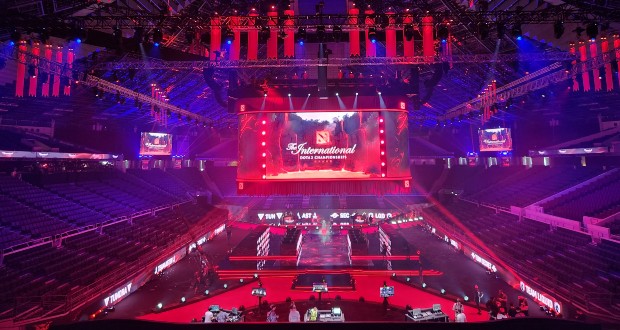The audio for the Defense of the Ancients 2 tournament at the Singapore Indoor Stadium was designed to mimic the sound an audience would hear if wearing headphones or watching at home.
Spectators at the Defense of the Ancients 2 (DOTA 2) esports world championship tournament at the Singapore Indoor Stadium enjoyed a visceral and immersive experience thanks to d&b Soundscape.
Sound designer and owner of post-production and live-events agency Aural Fixation, Jason Waggoner, has served as the live audio sound designer lead for the tournament since 2018 – and he has consistently opted for d&b products.
The d&b system primarily focused on game sounds, announcer commentary and video playback in the arena, as well as supporting live entertainment elements. While d&b has been part of the event for several years, it was the first time the audience was able to experience its Soundscape’s capabilities.
For the game’s developer, Valve, the audio in the arena needed to sound as close as possible to what it would be like if the audience was wearing headphones or watching at home.
“Soundscape gave the audience not only a better overall experience, but a more homogenous one to what they’re used to,” says Waggoner. “This audience is used to watching at home on Twitch and YouTube, probably on headphones, so we needed to deliver something more akin to that experience – but at the same time had all the excitement of a live show.”
As part of d&b’s ArrayCalc, Waggoner used the Soundscape Simulation software. The visualisation tool is designed to accurately model a Soundscape system’s real and perceived acoustical performance within a space. The En-Scene simulation tool allows d&b users to evaluate how the spatialisation created with a Soundscape system will be experienced, which helps audio technicians optimise system design early in a production’s planning phase.
“This feature allowed me to deploy the system in a non-traditional way, and to have a lot of flexibility in how the content was delivered to the audience,” says Waggoner.
Ian Davidson, the tournament’s FoH engineer, says: “The way Waggoner distributed the game sounds in Soundscape gave them a deeper and wider image than a traditional distribution, especially juxtaposed against our very forward ‘mono’ vocal channel, which was evenly distributed all sources. The result was a subtle, but effective, immersive experience.”
Waggoner’s audio team complemented Soundscape with d&b V series and ArrayProcessing. One of the major challenges of the audio production for the tournament is keeping as much audio as possible off the stage itself. The show that happens on Twitch is the same show going on in the arena, so if that sound is getting on to the stage and players can hear it, they may pick up something happening in a different part of the game that would potentially give them an unfair advantage.
Waggoner says the pattern control and cardioid nature of the V series helped prevent such a problem.
The team also used ArrayProcessing – an optional function within the d&b ArrayCalc simulation software – which uses an optimisation algorithm to determine tailored filters to help control the behaviour of a d&b line array system arranged in a LRC configuration across an entire listening area within the 12,000-seat stadium.
“Being able to use ArrayProcessing is pretty crucial because of the even coverage that you get and the more consistent frequency response across the audience area,” says Waggoner. “But it’s also effective for something else unique to esports: the play-by-play commentary is in the arena, not in a booth like it would be for a traditional sports broadcast. Using the cancellation functions within ArrayProcessing helps prevent as much extraneous audio as possible from echoing into the commentators’ headsets, which is critical for broadcast.
Reference : AVinteractive


